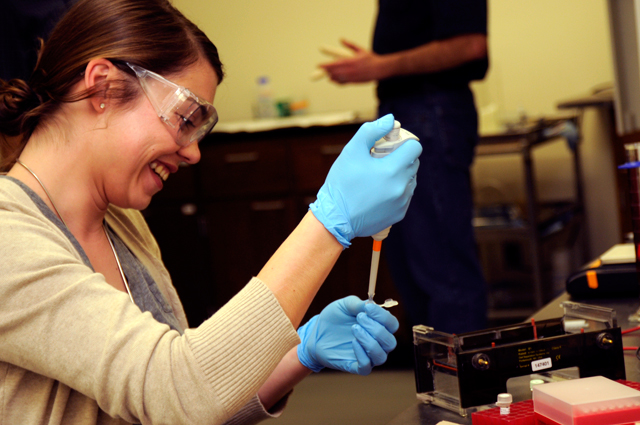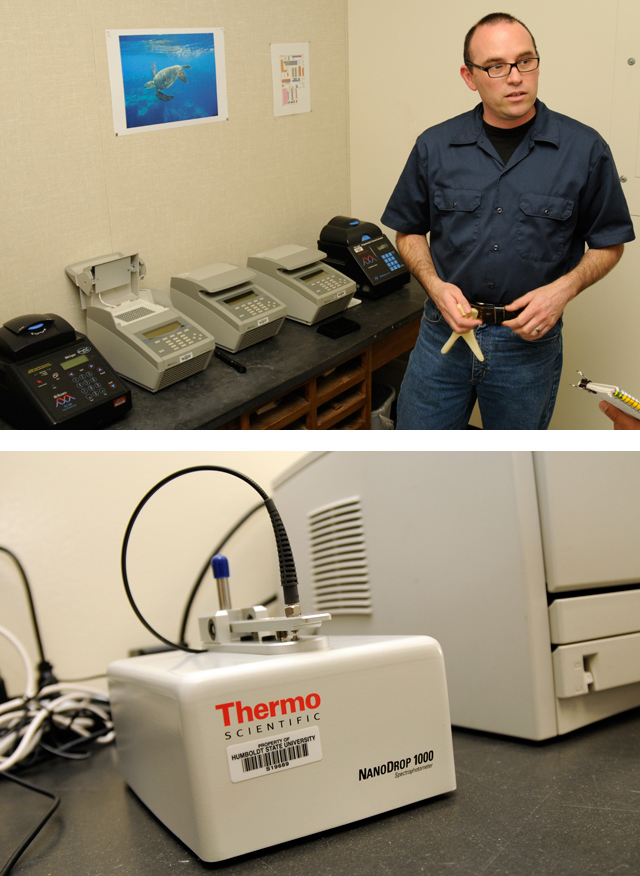
In 1985 scientists at England's University of Leicester developed a technique for establishing profiles of DNA samples and since that time major advancements have been made. As techniques have improved, DNA analysis has become common place in crime solving, but also in such fields as anthropology, botany and beyond.
With a recent spate of upgrades, what was originally HSU's biological sciences stock room has expanded to a fully functioning core facility designed to give Humboldt State's students first-hand access to proven DNA analysis techniques.
The official name of the renovated space is the Biology Core Facilities and it's been outfitted with a host of cutting-edge equipment that will make it easier than ever for students, faculty and the local community to take part in DNA research.
"This is really a CNRS lab, more than just a biology lab. I really want to get wildlife students, chemistry students, NRPI students in here and make this space available to anyone, really, who has the training to use this stuff," says Anthony Baker, manager of the core facilities.
According to Baker, the core is the culmination of work by a host of participants, all dedicated to expanding research opportunities for undergraduates at HSU.
"None of this would have been possible without the unfailing support of my department chairs over the years—Tim Lawlor, Milton Boyd and Casey Lu—and for the Core as it is today without the support of Dean Jim Howard and numerous individuals at Plant Ops. Without the vision and mentorship I received from numerous faculty specifically Jacob Varkey, William Allen (retired), Dave Largent (retired), Dennis Walker (retired) and Brian Arbogast, I am sure we would just have a stockroom at this point. And of course, without the students with whom I have worked with over the years I would have lacked the inspiration to put together the core in the way it is now," says Baker.

Inside the expanded Science B, room 230, visitors will hardly remember that this area was a typical, closed-door-style stockroom. A renovated interior features a new floor plan, a common area and a bank of high-speed computers for student use.
The backbone of the core facility is PCR, or polymerase chain reaction. It's a technique commonly used in microbiology to take a tiny amount of DNA—measured in nanograms—and multiply it in order to examine it in a variety of ways.
"PCR is revolutionary, it let's you take a small amount of DNA and amplify it so you can run a sequence of tests on it instead of using just the original sample," explains Baker.

The facility also includes a handful of PCR machines, including real-time PCR machines, and a spectrophotometer. The core is divided into several areas, with the Biology Core, or pre PCR area, occupying the front half of the room and the Biotechnology Core, or post PCR area, taking up the back. Additionally, the facility has a chemical-free work area, fume hood for chemical preparation and an electrophoresis area with two genetic analyzers.
After completing PCR, students can employ a DNA sequencer to run tests on their samples. The sequencer is generally considered an optical instrument in that it operates much like a CD player would--shining a laser on the dyed sample to produce the DNA sequence.
Some DNA analysis buffs might argue that the sequencer isn't really considered among the cutting edge. Baker explains that the idea behind keeping the older machines was to ensure student access.
"With the sequencer, even though they're older pieces and you can definitely get newer, more advanced equipment, students can come in any time of day and use these. With the new pieces, they use capillaries to see the DNA, which are really just tiny wires. If you break one of those, it's $800 so we wouldn't be able to let undergrads use them."
And student access is what this lab is all about. Baker says that students from various disciplines have used the equipment to study Sudden Oak Death, West Nile Virus and issues concerning the North Coast's fisheries.
Eventually, Baker hopes to open the core to the community as a way for the public to better understand biotechnology and raise awareness that high-tech DNA analysis can be accomplished right in here in Humboldt.
"This is going to be a resource. We want people to come in and ask questions. It's great for students, it puts them on the spot and makes them think. Plus is great training for the real world environment."